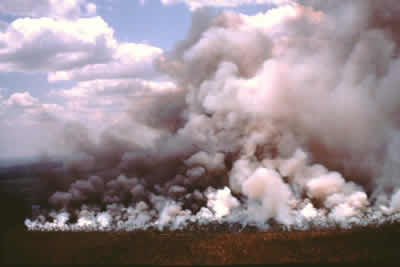Historically,
western policies such as fire-exclusion failed to accommodate the indigenous
knowledge systems in place across the country prior to European settlement
(Jurskis 2005). Westernised opinions of optimum land use for any given area
dictated the strategies used in fire management, an example of the ignorance
shown towards established knowledge systems and the holders of this knowledge.
An unequal power balance such as this not only belittles indigenous knowledge
from a western perspective, but contributes to social and cultural unrest within
indigenous cultures where the traditionally powerful holders of knowledge, the
elders, lose value and respect from younger generations (Trudgen
2000).
Clearly, the way fire is managed within Australia has great impact
upon many different life aspects, both human and environmental. It is a primary
incentive in the interests of all people to develop sustainable fire management
that embraces and incorporates both the dominant and indigenous knowledge
systems of this country.







Anthony Moore 153588
What is
at Stake?
Fire has a profound influence upon the ecosystems
in which it occurs. Burning frequency, timing or seasonality and intensity are
recognised as key parameters determining landscape response to fire, as well as
affecting the wider atmospheric environment (Bowman et al. 2007, Williams, P. et
al. 2003). Thus, changes to established fire regimes can significantly alter
abundance and composition of plants and animals within ecosystems, ultimately
causing loss of species and loss of unique biological communities (Bowman et al.
2008, Williams, R. et al. 2003, Yibarbuk 1998). Changes extend beyond
terrestrial landscapes – stream flow rates and sediment loads within rivers can
be strongly affected by bushfire in adjacent catchment areas, impacting aquatic
life (Lane et al. 2006). Further; high intensity fires deliver increased
atmospheric particle and CO2 pollution, contributing to an
acceleration of global warming and the associated future impacts (Miller 2005).
Double click
to edit
Extreme fire
events threaten human lives, as well as incurring ecological and economic costs
beyond measure. When an ignition source combines with fire-prone weather
conditions and excessive fuel accumulation, fire size and intensity can attain a
magnitude beyond fire fighting capabilities regardless of available resources
(Bushfire CRC 2006).
Extreme
bushfire events have caused devastation in Australian cities and towns on at
least seven occasions in the last 100 years (Geoscience Australia 2008). Impacts
extend through direct loss of human life and property, agricultural and
livestock losses, to destruction of native habitats and death of countless
native animals.




























